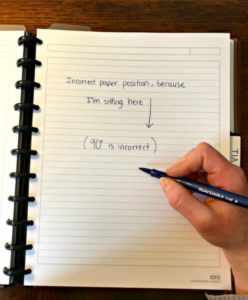
Despite the fact that computers are taking over the world (sort of) and most students use a word processor to type up essays and notes, there’s still a need for good old pen and paper. But with so much time spent typing, many of my students often have the worst handwriting I’ve ever seen illegible handwriting. And if something isn’t legible (readable), what’s the point of writing it in the first place?
So here I give you a few strategies for how to improve your handwriting without a ton of effort. Small stuff here, but big outcomes. Oh, and I’m saving the coolest tip for last! So definitely make sure you read number 6.
One more thing. You might be wondering how improving your handwriting relates to school. Two answers to this one (although I could give a million answers): 1) If teachers can’t read your writing, you won’t get a good grade. 2) If you can’t read your own handwriting, you won’t be able to study properly from your own notes.
How to improve your handwriting
1. Get inspired.
Spend some time searching through sites like Pinterest or even through the various fonts offered by Word or Google Docs (or whatever you use to type stuff). Take note of certain fonts that you admire or even just certain letter styles that you like. Let your “font collection” inspire you as you develop your own writing. Check out this Huffington Post article featuring 25 samples of perfect penmanship for even more ideas.
2. Get the right pen.
Such basic stuff here! But seriously, the right pen can make allllll the difference in your handwriting. Some people like ballpoint pens, some like felt-tip, others like fine Sharpie markers or gel pens (omg gel pens). Experiment! Snag the pen at the bank (what do you mean they’re not free?), borrow your friend’s pen at school, try sample pens at Staples (sometimes they let you try them out). You might go through like 10 different writing utensils before you strike gold, but once you find the pen, you’ll know. Keep in mind that the pen shouldn’t be too heavy or thick because holding it will exhaust your hand muscles after a while.
3. Use the right surface.
Our handwriting tends to be neater when we write on a somewhat forgiving surface. So double up the paper if you’re writing on a marble desk or kitchen counter. Use a notepad that has some padding from the pages underneath. A little hack is to slide a very thin, smooth piece of cardboard (like from a cereal box) under your paper to enhance the writing surface. It’s insane how much a small change like “padding the surface” can actually improve your handwriting. Oh, also: If you’re writing on paper without any lines, you can slip a piece of lined paper underneath to serve as a guide. Google “lined paper template” and print one out. Here’s a bunch of free paper printables, including graph paper and all sorts of lines.
4. Hold the pen and paper properly.
Pen grip is important: You should hold the pen (not squeeze the pen!) with your thumb and forefinger, while it rests on your middle finger. Here’s a very helpful video about proper pen grip. Or look at my lovely pen-grip demonstration in the pics below.
The angle of your paper is equally important. It’s best to angle your paper about 45 degrees as you write, instead of keeping it perpendicular to your body. Which way you angle the paper will depend on whether you’re a lefty or righty, and how acutely you angle your paper is a personal preference, but use the images below as a guide.


5. Slow down.
Want to know how to improve your handwriting without changing a single thing about your actual letters? Slow down! Seriously, slow down enough to actually pick up your pen between letters (unless you’re writing in cursive), form each letter completely before moving onto the next one, and make each letter the same size. When I write quickly, I tend to combine certain letters like “th” and “lt” — but when I slow down a tad, my writing becomes so much clearer. Try it!
6. BEST TIP EVER: Fix your messiest vowel.
I came up with this tip years ago when I was trying hopelessly to read a student’s handwritten SAT essay. I realized that the reason I couldn’t read his writing was because every ‘e’ looked like an ‘i’. So I couldn’t read any of his words that had an ‘e’ in them … which were a lot!
So here’s the trick: Find something that you wrote by hand, something at least a page in length. Examine your handwriting in search of your messiest vowel. I say vowel (instead of a consonant) because vowels are some of the most common letters. (If you want proof, read this article.) And from this point forward, make this particular vowel perfect every time you write it. Even if all your other letters remain messy, fixing this one vowel will make a huge difference in improving your handwriting. If all your vowels are messy, I recommend perfecting your ‘o’ before anything else. The reason for choosing to fix the ‘o’ is because so many other letters depend on the 0-shape (like a, b, d, g, p, q), so by default you’ll be neatening up your other letters too.
So if you’ve been told that your writing is messy, or if you just want to make it neater for you own sake, now you know how to improve your handwriting using the 6 tricks above. Even using just one of the tips will make a difference, but the more you use, the cleaner your penmanship will be. Write on, my friends. Write on.

